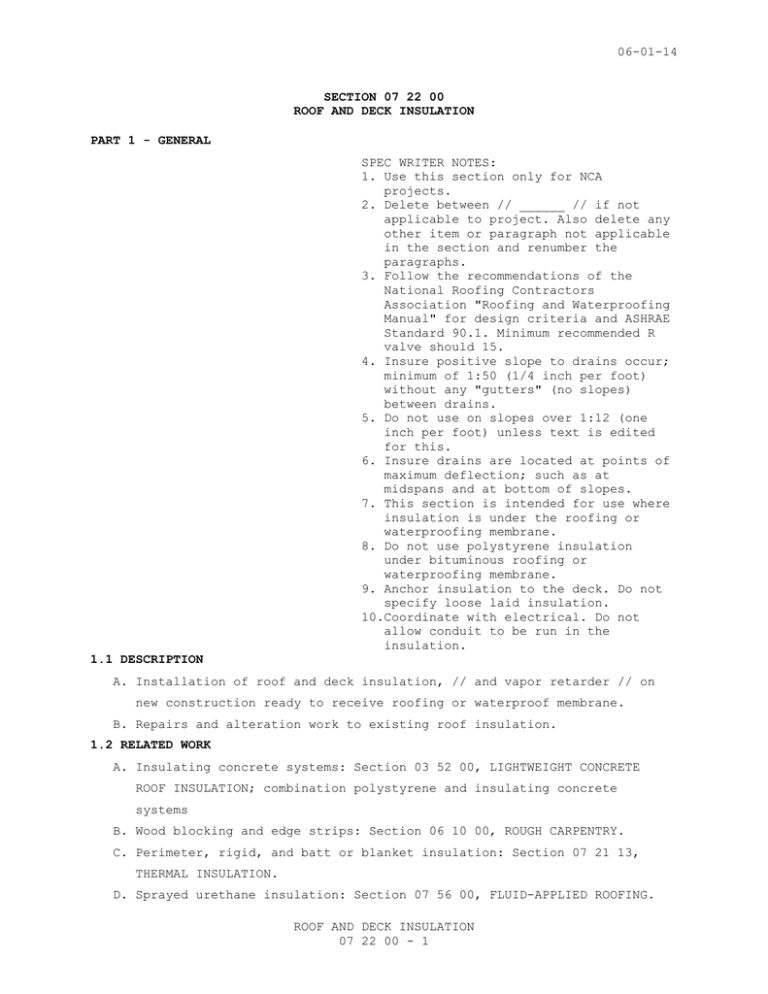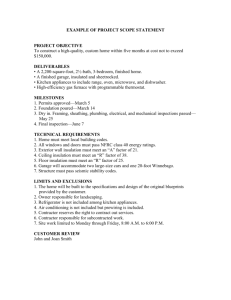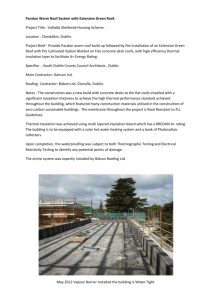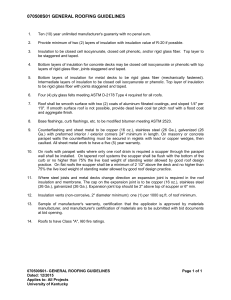06-01-14 SPEC WRITER NOTES: 1. Use this section only for NCA projects.
advertisement

06-01-14 SECTION 07 22 00 ROOF AND DECK INSULATION PART 1 - GENERAL SPEC WRITER NOTES: 1. Use this section only for NCA projects. 2. Delete between // ______ // if not applicable to project. Also delete any other item or paragraph not applicable in the section and renumber the paragraphs. 3. Follow the recommendations of the National Roofing Contractors Association "Roofing and Waterproofing Manual" for design criteria and ASHRAE Standard 90.1. Minimum recommended R valve should 15. 4. Insure positive slope to drains occur; minimum of 1:50 (1/4 inch per foot) without any "gutters" (no slopes) between drains. 5. Do not use on slopes over 1:12 (one inch per foot) unless text is edited for this. 6. Insure drains are located at points of maximum deflection; such as at midspans and at bottom of slopes. 7. This section is intended for use where insulation is under the roofing or waterproofing membrane. 8. Do not use polystyrene insulation under bituminous roofing or waterproofing membrane. 9. Anchor insulation to the deck. Do not specify loose laid insulation. 10.Coordinate with electrical. Do not allow conduit to be run in the insulation. 1.1 DESCRIPTION A. Installation of roof and deck insulation, // and vapor retarder // on new construction ready to receive roofing or waterproof membrane. B. Repairs and alteration work to existing roof insulation. 1.2 RELATED WORK A. Insulating concrete systems: Section 03 52 00, LIGHTWEIGHT CONCRETE ROOF INSULATION; combination polystyrene and insulating concrete systems B. Wood blocking and edge strips: Section 06 10 00, ROUGH CARPENTRY. C. Perimeter, rigid, and batt or blanket insulation: Section 07 21 13, THERMAL INSULATION. D. Sprayed urethane insulation: Section 07 56 00, FLUID-APPLIED ROOFING. ROOF AND DECK INSULATION 07 22 00 - 1 06-01-14 E. Sheet metal components: Section 07 60 00, FLASHING AND SHEET METAL. 1.3 QUALITY CONTROL A. Supervision of work by persons that are knowledgeable and experienced in roofing. See submittals for documentation of supervisor’s qualification. B. Unless specified otherwise, comply with the recommendations of the NRCA "Roofing and Waterproofing Manual" applicable to insulation for storage, handling, and application. 1.4 SUBMITTALS A. Submit in accordance with Section 01 33 23, SHOP DRAWINGS, PRODUCT DATA, AND SAMPLES. B. Manufacturer's Literature and Data: 1. Asphalt materials, each type 2. Roofing cement, each type 3. Roof insulation, each type 4. Fastening requirements 5. Insulation span data for flutes of metal decks C. Samples: 1. Roof insulation, each type 2. Nails and fasteners, each type D. Certificates: 1. Indicating type, thickness and thermal conductance of insulation. // (Average thickness for tapered insulation). // 2. Indicating materials and method of application of insulation system on metal decks meet the requirements of Factory Mutual Research Corporation for Class 1 Insulated Steel Deck Roofs. //E. Laboratory Test Reports: Thermal values of insulation products.// //F. Layout of tapered roof system showing units required. // G. Documentation of supervisors training and experience showing knowledge of roofing procedures. 1.5 DELIVERY, STORAGE AND MARKING A. Deliver materials to the site in original sealed packages or containers marked with the name and brand, or trademark of the manufacturer or seller. B. Keep materials dry, and store in dry, weather tight facilities or under canvas tarps. Use of polyethylene or plastic tarps to cover materials is not permitted. Store above ground or deck level on wood pallets. Cover ground under stored materials with plastic tarp. ROOF AND DECK INSULATION 07 22 00 - 2 06-01-14 1. Store rolled materials (felts, base sheets, paper) on end. Do not store materials on top of rolled material. 2. Store foam insulation away from areas where welding is being performed and where contact with open flames is possible. C. Protect from damage from handling, weather and construction operations before, during, and after installation. SPEC WRITER NOTES: Update applicable publications to current issue at time of project specification preparation. 1.6 APPLICABLE PUBLICATIONS A. The publications listed below form a part of this specification to the extent referenced. The publications are referenced in the text by the basic designation only. B. American Society for Testing and Materials (ASTM): C1289-10................Faced Rigid Cellular Polyisocynurate Thermal Insulation Board D41-11..................Asphalt Primer Used in Roofing, Dampproofing, and Waterproofing D312-00(R2006)..........Asphalt Used in Roofing D2178-04................Asphalt Glass Felt Used in Roofing and Waterproofing D2822-05(R2011).........Asphalt Roof Cement D4897-01(2009)..........Asphalt Coated Glass Fiber Venting Base Sheet C. Factory Mutual Global (FM): 4450-89.................Approved Standard for Class 1 Insulated Steel Deck Roofs D. National Roofing Contractors Association (NRCA): The NRCA Roofing and Waterproofing Manual - Fifth Edition (2009). E. Underwriters Laboratories, Inc. (UL): Fire Resistance Directory (2009) SPEC WRITER NOTES: Update material requirements to agree with applicable requirements (types, grades, classes,) specified in the referenced Applicable Publications. 1.7 QUALITY ASSURANCE: A. Roof insulation on combustible or steel decks shall have a flame spread rating not greater than 75 and a smoke developed rating not greater than 150, exclusive of covering, when tested in accordance with ASTM E84, or shall have successfully passed FM Approvals 4450. ROOF AND DECK INSULATION 07 22 00 - 3 06-01-14 1. Insulation bearing the UL label and listed in the UL Building Materials Directory as meeting the flame spread and smoke developed ratings will be accepted in-lieu-of copies of test reports. 2. Compliance with flame spread and smoke developed ratings will not be required when insulation has been tested as part of a roof construction assembly of the particular type used for this project and the construction is listed as fire-classified in the UL Building Materials Directory or listed as Class I roof deck construction in the FM Approvals "RoofNav." 3. Insulation tested as part of a roof construction assembly shall bear UL or FM labels attesting to the ratings specified herein. SPEC WRITER NOTES: Update material requirements to agree with applicable requirements (types, grades, classes), specified in the referenced Applicable Publications. PART 2 - PRODUCTS 2.1 ASPHALT MATERIALS A. Primer: ASTM D41. B. Asphalt: ASTM D312, Type III or IV for vapor retarders and insulation. C. Glass (Felt): ASTM D2178, Type IV, heavy duty ply sheet. D. Venting Asphalt Base Sheet: ASTM D4897, Type I or Type II. E. Roof Cement: ASTM D2822, Type I or Type II, asbestos free; or, D4586, Type I or Type II. 2.2 INSULATION A. Isocyanurate Board: ASTM C1289, Type I, Class 2 or Type III. B. Tapered Roof Insulation System Segments: 1. Fabricate of mineral fiberboard, isocyanurate, perlite board, or cellular glass. Use only one insulation material for tapered sections. 2. Cut to provide high and low points with crickets and slopes as shown. 3. Minimum thickness of tapered sections; 13 mm (1/2 inch), unless manufacturers allow taper to zero mm (inch). 2.3 FASTENERS A. Fasteners for securing insulation to steel decks: 1. Conform to requirements of Factory Mutual Research Corporation for wind uplift. 2. Self-drilling galvanized screws with 50 mm (two inch) diameter disk. ROOF AND DECK INSULATION 07 22 00 - 4 06-01-14 3. Antibackout thread design. 4. Have a pullout resistance of 14 kg (30 pounds) minimum. 2.4 RECOVERED MATERIALS A. Comply with following minimum content standards for recovered materials: Material Type Percent by Weight Plastic rigid foams: Polyisocyanurate/polyurethane Rigid foam 9 percent recovered material Foam-in-place 5 percent recovered material Glass fiber reinforced 6 percent recovered material Rock wool material 75 percent recovered material B. The minimum-content standards are based on the weight (not the volume) of the material in the insulating core only. PART 3 - EXECUTION 3.1 GENERAL A. Do not apply roof insulation if deck will be used for subsequent work platform, storage of materials, or staging or scaffolding will be erected thereon. B. Entire roof deck construction of any section of the building shall be completed before insulation system work is begun. Curbs, blocking, edge strips, and other components which insulation, roofing and base flashing is attached to shall be in place ready to receive insulation and roofing. Coordinate roof insulation operations with roofing and sheet metal work so that insulation is installed to permit continuous roofing operations. C. Insulation system materials shall be dry and damage free when applied. Do not use broken insulation or insulation with damaged facings. Remove damaged insulation from the site immediately. D. Dry out surfaces //, including the flutes of metal deck, // that become wet from any cause during progress of the work before roofing work is resumed. Apply materials only to dry substrates. E. Do not apply materials during damp or rainy weather, during excessive wind conditions, nor while moisture (dew, fog, snow, ice) or frost is present in any amount in or on the materials when temperature is below 10 C (50 F). Do not apply materials to substrate having temperature of 10 C (50 F) or less. ROOF AND DECK INSULATION 07 22 00 - 5 06-01-14 F. Phased construction is not permitted. The complete installation of all flashing, insulation, and roofing shall be completed in the same day except for the area where temporary protection is required when work is stopped. 3.2 SURFACE PREPARATION A. Sweep decks to broom clean condition. Remove all dust, dirt or debris. B. Remove projections that might damage materials. C. Existing Roofs: 1. At areas to be altered or repaired, remove loose insulation and wet insulation. 2. Cut and remove existing insulation and vapor retarder for new work to be installed. Clean cut edges and install a temporary seal to cut surfaces. Use roof cement and one layer of 7 kg (15 pound) felt strip cut to extend 150 mm (6 inches) on each side of cut surface. Bed strip in roof cement and cover strip with roof cement to completely embed the felt. SPEC WRITER NOTES: Vapor retarders shall be considered for use over decks to receive insulation for heated buildings where the January average means temperature is below 4.5 C (40 F), the relative humidity is 45 percent or greater, and should always be specified for heated buildings where a high humidity condition is expected such as a kitchen, indoor swimming pool, or laundry. Use venting base sheet over all insulating concrete and poured gypsum decks to relieve possible vapor pressures that may occur. The venting base sheet also acts as a vapor retarder when insulation is solid mopped over the venting base sheet. As a general rule, follow NRCA procedures for determining if vapor retarders are required including venting and ASHRAE for calculations; however, under conditions of extreme humidity and cold weather conditions, the need for a vapor retarder is essential and calculations are necessary. Insure that the vapor retarder is shown at all locations where required on the drawings. 3.3 VAPOR RETARDER A. General: 1. // Install a continuous vapor retarder on roof decks as specified. // Install a vapor retarder when phenolic insulation is used. ROOF AND DECK INSULATION 07 22 00 - 6 06-01-14 2. At vertical surfaces, turn up vapor retarder to top of insulation or base flashing. 3. At all pipes, walls, and similar penetrations through vapor retarder, seal openings with roof cement to prevent moisture entry from below. 4. Mop felts solidly in place as specified. 5. Seal penetrations with roof cement. 3.4. INSULATION THICKNESS 1. Thickness of roof insulation shown on drawings is nominal. Actual thickness shall provide the thermal resistance "R" value of not less than specified. SPEC WRITER NOTES: Verify sufficient "R" occurs over vapor retarder to prevent condensation, especially over insulating concrete decks. 2. // The minimum thickness of insulation for metal decks shall not be less than recommended by the insulation manufacturer to span the rib opening (flute size) of the metal deck used. // 3. When thickness of insulation to be used is more or less than that shown on the drawings, make adjustments in the alignment and location of roof drains, flashing, gravel stops, fascias and similar items at no additional cost to the Government. SPEC WRITER NOTES: Insure roof slopes high and low points are shown on the roof plan including crickets. Do not have "gutters" or level areas between drains. Insure drains are located at low points. Insure correct geometry is shown for slope. 4. Tapered insulation shall be preformed and fabricated to the slopes indicated. 5. Use not less than two layers of insulation when insulation is 25 mm (one inch) or more in thickness unless specified otherwise. 3.5 INSTALLATION OF INSULATION A. Lay insulating units with close joints, in regular courses and with cross joints broken. When laid in more than one layer, break joints of succeeding layers of roof insulation with those in preceding layer. Bed insulation layers in Type III or IV asphalt firmly pressed into the hot bitumen. Keep bitumen below surface of insulation to receive single ply rubber roofing. ROOF AND DECK INSULATION 07 22 00 - 7 06-01-14 B. Lay units with long dimension perpendicular to the rolled (longitudinal) direction of the roofing felt. C. Cover all insulation installed on the same day by either: 1. The roofing membrane as specified. 2. Temporary protection as specified. D. Seal all cut edges at penetrations and at edges against blocking with bitumen or roof cement. SPEC WRITER NOTES: Insulation is required to be mechanically anchored to steel decks. Delete non applicable text. Refer to FM Building Materials and Construction requirements for resistance to wind storm uplift. Where no windstorm requirement is required, use 1-60 requirement. Design for wind conditions of area where building is constructed. E. Cut to fit tight against blocking or penetrations. F. Over Vapor Retarder: Lay insulation in hot bitumen as specified. SPEC WRITER NOTES: Delete paragraph G if vapor retarder is specified. Use only when no vapor retarder is required over steel deck for insulation to span flutes for solid substrate of roof membrane. G. Steel Deck: 1. Material and method of application of insulation systems used on metal decks shall meet the requirements of Underwriters laboratories for Class A or Factory Mutual Research Corporation for Class I Insulated Steel Roof Deck. 2. Mechanically anchor first layer of insulation to steel deck to conform to FM Class // 1-60 // 1-90 //, Insulated Steel Roof Deck. 3. Locate the long dimension edge joints to have solid bearing on top of deck ribs; do not cantilever over deck rib openings or flutes. - - - E N D - - - ROOF AND DECK INSULATION 07 22 00 - 8


